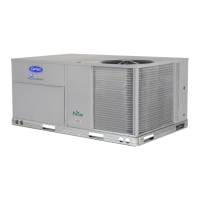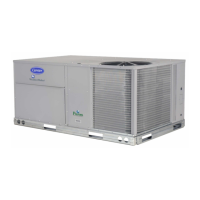179
Fig. 97 — Recommended Minimum Cool-Down Time
After Compressor is Stopped*
Crankcase Heater
Each compressor has a crankcase heater to prevent absorption
of liquid refrigerant by oil in the crankcase when the compres-
sor is idle. Since 115-v power for the crankcase heaters is
drawn from the unit control circuit, main unit power must be
on for the heaters to be energized.
EVAPORATOR-FAN MOTOR PROTECTION
A manual reset, calibrated trip, magnetic circuit breaker pro-
tects against overcurrent. Do not bypass connections or in-
crease the size of the breaker to correct trouble. Determine the
cause and correct it before resetting the breaker.
CONDENSER-FAN MOTOR PROTECTION
Each condenser-fan motor is internally protected against over-
temperature. They are also protected against a severe over-cur-
rent condition by manual reset, calibrated trip, magnetic circuit
breakers on a common circuit. As with the circuit breakers, do
not bypass connections or increase breaker size to correct trou-
ble. Determine the cause and correct it before resetting the
breaker.
HIGH-PRESSURE SWITCHES
Settings for these switches are shown in Tables 119 and 120. If
either switch trips, that refrigerant circuit will be automatically
locked out by the controls. To reset, set ALARMS
R.CUR =
YES.
Table 119 — Pressure Switch Settings (psig)
Table 120 — Pressure Switch Settings (kPa)
Temperature Relief Devices
All units have temperature relief devices to protect against damage
from excessive pressures caused by extreme high temperatures
(i.e., fire). These devices protect the high and low side.
Control Circuit, 115 V
This control circuit is protected against overcurrent by a
10 amp circuit breaker. Breaker can be reset. If it trips, deter-
mine cause of trouble before resetting.
Control Circuit, 24 V
This control circuit is protected against overcurrent by two
10 amp and four 3.2 amp circuit breakers. Breakers can be reset.
If a breaker trips, determine cause of trouble before resetting.
Gas Heat (48P Only)
LIMIT SWITCHES
The maximum supply-air temperature is controlled by a limit
switch located in the gas section. The limit is designed to trip at
100°F above the maximum temperature rise.
When the limit trips, 2 flashes occur on the IGC board. The gas
valve is deenergized. After cooling, the system will reset and
fires gas again. If four trips occur, the system shuts down into
Lockout and 4 flashes occur on the IGC board. The system
must then be manually reset by power down and power up of
the unit.
LIMIT SWITCH THERMISTOR (Staged Gas Unit Only)
The limit switch thermistor is a factory-installed component. It
is located next to the lower limit switch. The limit switch
thermistor senses temperature at limit switch location and pre-
vents the limit from tripping while the unit is operating at low
airflow.
PRESSURE SWITCH (Modulating Gas Units Only)
This switch senses vacuum to ensure the proper function of
combustion induced-draft blower. It is a normally open switch
set to close on negative pressure rise. The pressure switch is lo-
cated next to ignition and modulating gas controllers in the gas
section.
ROLLOUT SWITCH
This switch senses any flame or excessive heat in the main
burner compartment and deenergizes the gas valve. If this oc-
curs, the gas heating system is locked out (7 flashes on IGC
board) until the rollout switch is reset manually. Reset rollout
switch manually by powering down and powering up of the
unit.
When the rollout switch trips, it usually indicates a flue block-
age. Inspect the unit for any obstruction in the flue system, for
holes in the flue box, a defective hall effect sensor or pressure
switch, a defective inducer motor, or a loose combustion blower.
Compressor Removal
All compressors can be removed from the compressor side of
the unit.
1. Disconnect power to unit; lockout power to compressor.
2. Close suction and discharge service valves.
3. Relieve refrigerant pressure into a refrigerant recovery
system.
4. Disconnect power wires at terminal box and disconnect
conduit.
5. Disconnect wires from crankcase heater.
6. Lift compressor off mounting bolts and remove.
Compressor Replacement
Perform the following:
1. Reverse procedure in Compressor Removal section.
2. Leak-check and evacuate system, recover refrigerant.
3. Recharge system per pre-start-up and start-up sequences.
Recheck oil levels.
4. Energize crankcase heater for 24 hours prior to restart of
system.
IMPORTANT: After a prolonged shutdown or service job,
energize the crankcase heaters for 24 hours before starting
the compressor.
SWITCH CUTOUT CUT-IN
High 650 10 500 15
SWITCH CUTOUT CUT-IN
High 4482 69 3447 103
0
10
20
30
40
50
60
70
80
90
100
110
120
0 102030405060708090
Recommended Cooling Time
(Minutes)
Compressor Unloaded Run Time (Minutes)
*Times are approximate.
NOTE: Various factors, including high humidity, high ambient tempera-
ture, and the presence of a sound blanket will increase cool-down times.
IMPORTANT: All compressor mounting hardware and
support brackets removed during servicing must be rein-
stalled prior to start-up.

